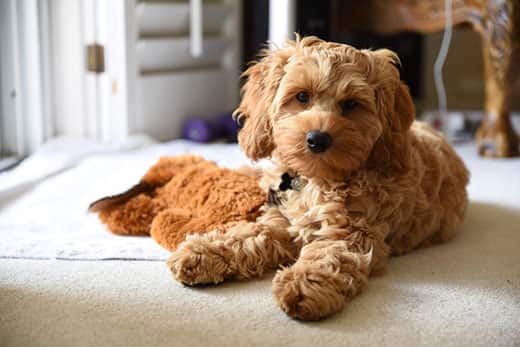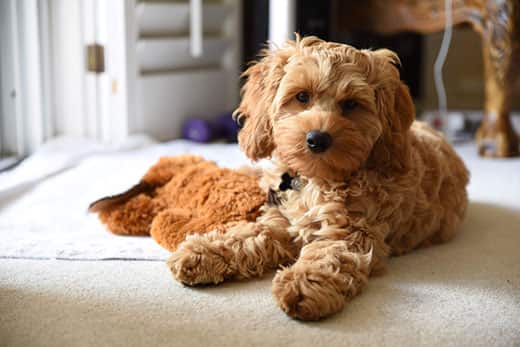Are you the proud new pet parent of a Cockapoo? Would you like to know how much exercise he needs? If so, then you’ve come to the right place!
Connect with a verified veterinarian in minutes. Licensed vets are available 24/7 to answer your questions. No need to worry about your furry family member.
We’ve put together some information about the Cockapoo, how much exercise they need, as well as a list of activities you can enjoy together! Let’s get started!
What is a Cockapoo?
The Cockapoo is a combination of a Poodle and a Cocker Spaniel. The result is a hybrid dog, which is not a specific breed. Instead, these dogs are called “designer dogs.” They first became popular back in the 60s. These beautiful dogs are very intelligent, low-shedding dogs. And they’re known for being affectionate and easygoing fur babies.
These adorable dogs come in four sizes:
- Teacup toy: is less than 6 lbs and less than 10 inches tall
- Toy Cockapoo: is under 12 lbs and about 10 inches tall
- Miniature Cockapoo: is about 13-18 lbs and stands between 11-14 inches tall
- Standard (also called Maxi Cockapoo): is about 19lbs + and about 15 inches tall
Cockapoos have an average life span of 12-15 years.
Cockapoo Personality
Cockapoos have become one of the most popular companion dogs, for a good reason. The dogs are friendly and happy. If you need a happy fix, go right now and search for a photo of a Cockapoo. You won’t be able to frown—you’ll have a huge smile when you see one of these adorable dogs! They have such sweet faces; you can’t help but say, “Awhhhh.”
These dogs are pretty smart, just like their Poodle ancestors. Even so, Cockapoos do require early socialization when they’re puppies. This makes sure the puppy grows into a well-adjusted adult dog. They’re also easy to train, responding well to positive reinforcement training methods.
Cockapoos want nothing more than to be with their family and pet parents. For this reason, Cockapoos can suffer from separation anxiety if left alone for long periods. In that case, the dogs can become quite destructive. They may also develop a habit of excessive barking.
These dogs do very well with older kids, as well as other dogs and pets.
When it comes to energy levels, you might say the Cockapoo comes somewhere in the middle. They love to go for walks and play. They will need at least 15 minutes of exercise every day. So, they’re not as high-energy as some dogs, but they can suffer from too much energy, too.
Cockapoos can live just about anywhere; they do well in apartments but not as well in kennels or outside.

Review symptoms, medications & behavior to keep your pets healthy with a Vet Online in just minutes.
Ask a Vet Live NowGrooming a Cockapoo
Cockapoos have a long coat with hair that goes from straight to long curls. So cute! They come in a wide range of colors, too. Some pet parents like to have their Cockapoos’ hair clipped. In that case, the coat can be trimmed to 2-3 inches in length, and it needs daily brushing.
How Much Exercise Does a Cockapoo Need?
We answered that above, but we’ll share the information again here. A Cockapoo needs at least 20-30 minutes of exercise a day. You can take your fur baby out for a couple of walks each day. This could be one in the morning and one in the evening.
A couple of walks each day will help your canine companion stay healthy, at a healthy weight, and wear off excess energy. Remember, a tired dog can’t get into mischief!
Fun Activities for You and Your Cockapoo!
Here are some fun activities you and your Cockapoo can enjoy together! Not only will you have fun together, but you’ll also both stay in shape!
1). Daily Walk
This is one of the best ways to exercise your Cockapoo each day! It’s best to aim for two daily walks that are about 20-30 minutes each, at a pace that’s comfortable for your fur baby. Some Cockapoos have quite a bit of endurance and may not mind going for a longer walk if possible. Remember, the more energy you wear off, the more mischief you’ll avert!
It’s best to keep your canine companion on a loose leash and use a harness. A harness gives you more control of the dog’s upper body. Plus, the harness keeps the dog from choking if he’s pulling. A collar really is not a good idea.
Here’s a harness you might like:
Gooby Dog Harness: this harness comes in a range of sizes and colors and is made of 100% polyester mesh, which allows airflow through the harness. The mesh is also machine washable. You’ll have more control of your dog, and he won’t choke if pulling.
2). Play Dates with Other Dogs
This is another great way to ensure your fur baby gets plenty of exercise! What could be more fun than a bunch of dogs having fun together? They’ll burn off excess energy, benefit from the mental stimulation, and work on social skills.
This would be a great time to get together with the other pet parents, too! Have a picnic outside while supervising the dogs. What could be better?
3). Play Fetch
Here’s another fun activity to play with your Cockapoo—fetch! Not all dogs understand this game at first, so your fur baby may need some training. If your dog runs off with the ball, it will be necessary to reinforce recall cues and related skills.
Another issue some dogs have is not giving up the ball. This is usually due to not understanding the game and/or being possessive of their toys. However, some dogs understand that if they don’t give up the ball, you’ll come running after them. That means the game of fetch turns into catch me if you can!
If your dog has this issue, then you’ll need to teach them how to “drop it.” It takes time to teach your dog to play fetch but don’t give up! Your fur baby wants to have fun time with you! He’ll get the hang of the game!
Here’s a great toy that can be used for fetch and tug of war:
Chuckit! Ultra Tug: this is a fun toy that’s part ball and part tug o war toy! This is a tough toy that’s built for throwing and chewing. The ball is made of durable rubber, and the 2-ply nylon band will last through many games of fetch.
Kong Flyer: this is another toy that’s great for playing fetch. The Kong Flyer is made of natural rubber, which means it is safe for your Cockapoo and durable. The disk is flexible and won’t hurt your dog’s teeth or mouth. It’s also easy to grip. Watch your dog run and fly as he chases the Kong Flyer!
4). Retrieval Training
This game goes along with playing fetch! It teaches your dog how to chase, retrieve, and return a toy. Your Cockapoo will get plenty of exercise, learn new skills, and more. What’s more, you and your canine companion will enjoy so much fun together, as well as deepening the bond between you.
When you’re ready to start retrieval training, choose a toy that your dog loves. It may take some experimenting to find “the” toy. It might turn out to be a ball, a flying disk, or even a stick. Whatever the toy is, just make sure your dog really wants it!
Next, it helps to use treats to motivate your fur baby. Some dogs get tired of playing retrieval, and Cockapoos are not one of the most athletic dogs around. So, find a treat your fur baby loves and use this to keep him playing. Be sure to reward him each time he brings the toy back.
For dogs that chase but don’t bring the toy back, you can try having a second toy ready to throw right away. When your dog has the first toy, throw the second in a completely different direction. Another option is to get your dog’s attention and give them the cue for “drop it.”
It may take some trial and error, but eventually, your canine companion will understand the game. And when he does, watch out! He’ll want to play it all the time!
5). Swimming
Cockapoos are natural swimmers! This is because Poodles were bred to retrieve game birds from the water. Spaniels also do well in the water. Swimming is an excellent exercise that works the entire body at one time. All major muscle groups are used, which means your fur baby will get a pretty good workout.
If your dog is new to swimming, that’s OK. You can teach him how to swim. You may want to start out in a pool or a lake, where the water is calm and not too deep. Another good idea is to purchase a dog swim vest, like this one:
Outward Hound Life Jacket: this is a swim vest/life jacket that’s made to support your dog in the water. The vest is made of bright colors and reflective accents to make dogs more visible when swimming. There’s even a front float support that keeps the dog’s head above water. The fabric increases the dog’s buoyancy in the water without restricting movement. And there are grab handles, which make it easy to grab the dog out of the water if he’s having trouble.
Remember to take things slowly when training your dog to swim. Don’t force your dog or throw him in the water. That simply makes him terrified of the water. Instead, be gentle, calm, and supportive. And be sure to keep this a fun activity. Treats can also help motivate your dog to learn how to swim.
There you have it! These are some fun ways to exercise your Cockapoo! You can both have a great time staying in shape as you bond over these fun experiences!
Connect with a verified veterinarian in minutes. Licensed vets are available 24/7 to answer your questions. No need to worry about your furry family member.

Julie
Julie is a graduate of the University of North Carolina, Wilmington, where she studied Animal science. Though contrary to the opinion of her parents she was meant to study pharmacy, but she was in love with animals especially cats. Julie currently works in an animal research institute (NGO) in California and loves spending quality time with her little cat. She has the passion for making research about animals, how they survive, their way of life among others and publishes it. Julie is also happily married with two kids.
Review symptoms, medications & behavior to keep your pets healthy with a Vet Online in just minutes.
Ask a Vet Live Now



